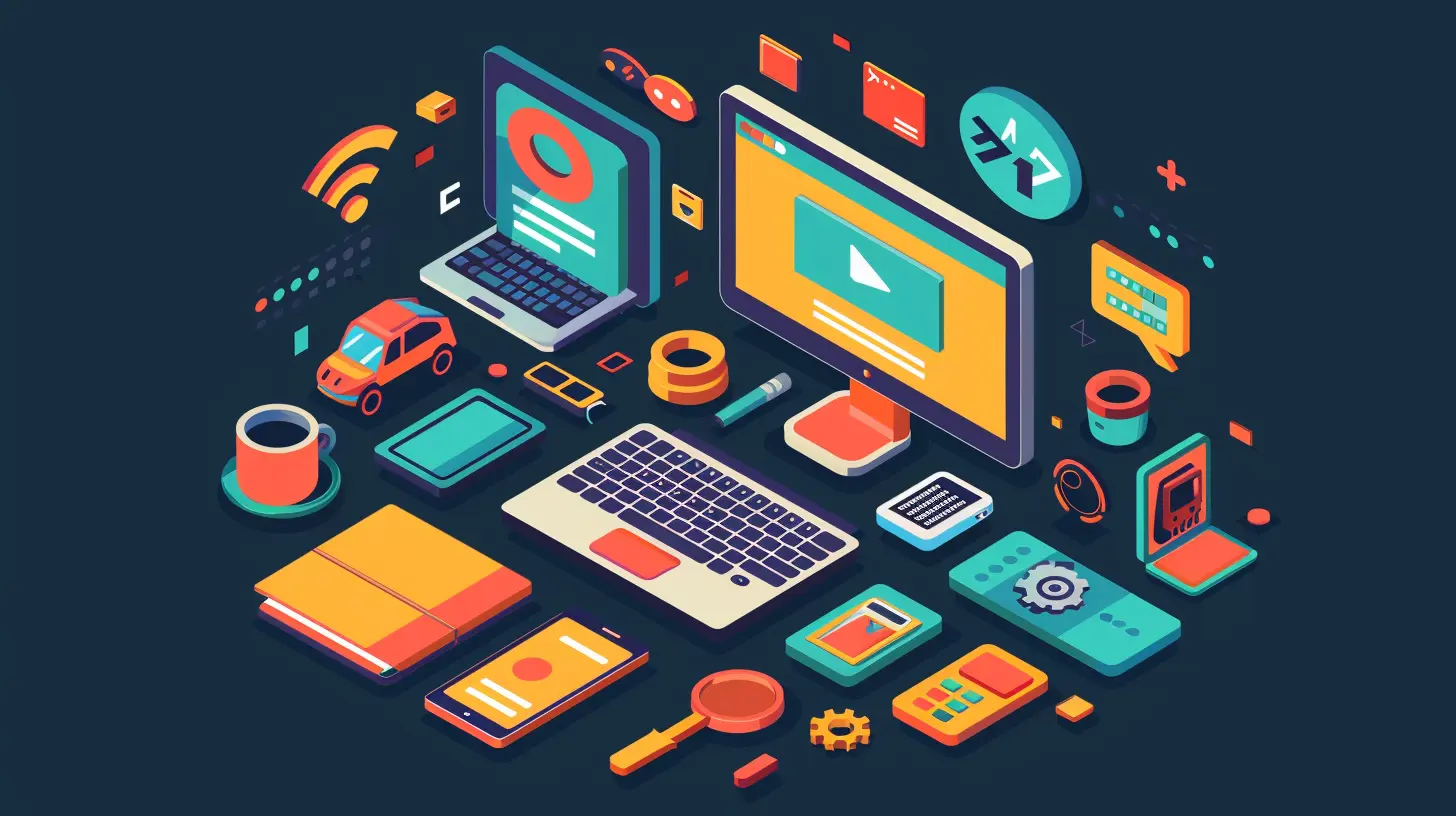Best Practices for Migrating Legacy Apps to Modern Frameworks
31 December 2024
In the fast-evolving world of technology, businesses often find themselves holding onto legacy apps that feel like they're stuck in a time warp. Whether it’s a system that’s been around for a decade or an app built on an outdated framework, companies eventually face the daunting task of migrating these legacy applications to modern frameworks. But, let’s face it — migration isn’t a walk in the park. It’s more like trying to move a fully furnished house across town, and you don’t want to break anything along the way.
The goal here is to upgrade to something faster, more secure, and easier to maintain without disrupting your business operations. Sounds tricky, right? Don’t worry, I’ve got you covered. In this article, we’ll dive into the best practices for migrating legacy apps to modern frameworks, ensuring the transition is as smooth as possible.

Why Migrate Legacy Apps?
Before we dive into the nitty-gritty, let’s address the elephant in the room: why should you even bother migrating legacy apps? Sure, they’re old, but if they still work, why fix what isn’t broken?Well, here’s the thing — while your legacy app may still function, it’s probably holding you back in more ways than you realize. Here's why:
1. Performance Issues: Older frameworks are often not optimized for modern hardware, leading to slower performance.
2. Security Vulnerabilities: Legacy systems can have unpatched vulnerabilities that make them easy targets for hackers.
3. Maintenance Nightmares: The cost of maintaining outdated software can skyrocket, especially if the original developers are long gone.
4. Scalability: Modern businesses need scalable solutions, which older apps often fail to provide.
5. Compatibility: Legacy systems may not play well with new technologies or third-party integrations.
So, while your old app may still be chugging along, it's likely costing you more in the long run — both in terms of money and missed opportunities.

Best Practices for Migrating Legacy Apps to Modern Frameworks
Now, let's roll up our sleeves and get into the best practices for migrating your legacy app. These strategies will help ensure that the process is efficient and, more importantly, successful.
1. Assess Your Legacy Application
Before you even think about migration, you need to take a hard look at your legacy app. This is like taking your car to the mechanic before a road trip — you need to know what you’re working with.Ask yourself:
- What is the current state of the application?
- What are the pain points (performance, security, user experience)?
- What are the business-critical features that must be preserved?
- Are there any outdated technologies or libraries that need to be replaced?
Document everything. The more you know about your app's current state, the fewer surprises you'll encounter during the migration process.
How to Assess:
- Code Review: Dive deep into the codebase. Identify outdated dependencies or libraries, and check for areas where the code could be optimized.- Performance KPIs: Measure the current app's performance. Keep track of load times, response times, and error rates.
- Security Audit: Conduct a security audit to find vulnerabilities that need to be addressed during the migration.
2. Choose the Right Modern Framework
Choosing the right framework for your migration is like picking the right vehicle for your trip. You want something that’s reliable, fast, and can handle the distance. When it comes to modern frameworks, there are plenty to choose from: React, Angular, Vue.js, Django, Ruby on Rails, Spring Boot, and more. The right choice depends on your specific needs.Factors to Consider:
- Scalability: Will the framework scale as your business grows?- Performance: Does it offer better performance compared to your legacy framework?
- Community Support: A well-supported framework with active community contributions is less likely to become obsolete.
- Ease of Use: How easy will it be for your team to learn and work with this framework?
Popular Modern Frameworks:
- Frontend: React, Angular, Vue.js- Backend: Node.js, Django, Spring Boot, Ruby on Rails
- Mobile: Flutter, React Native
Remember, the goal here isn't to chase the latest trend but to choose a framework that aligns with your long-term goals.
3. Plan Your Migration Strategy
Once you’ve chosen a modern framework, it’s time to plan how you'll migrate. And trust me, you don't want to wing it here. A migration without a solid plan is like trying to build a house without blueprints — it's bound to go wrong.There are multiple approaches to migrating legacy apps, depending on your business needs and risk tolerance.
Common Migration Strategies:
- Big Bang Migration: This is when you migrate the entire app in one go. While it sounds efficient, it’s risky. If something goes wrong, you could be left with a broken app and no fallback.- Phased Migration: This approach involves breaking the app into smaller parts and migrating piece by piece. It’s safer but takes more time.
- Parallel Migration: You run both the legacy app and the new app side by side during the migration. It’s a great way to test the new system without disrupting the old one.
4. Refactor and Rebuild Where Necessary
Let’s be honest — some parts of your legacy app are probably outdated beyond repair. Rather than trying to force it into a modern framework, consider refactoring or even rebuilding those parts from scratch.When to Refactor:
- If the codebase is mostly functional but could use some optimization, refactoring is the way to go.- If some parts of the app are tightly coupled and hard to maintain, breaking them down into more modular components can make future updates easier.
When to Rebuild:
- If the code is spaghetti-level messy and impossible to maintain, rebuilding might be the smarter option.- If your app’s architecture is completely incompatible with modern frameworks, it’s time for a rebuild.
5. Prioritize Performance Optimization
Now that you’re working with modern frameworks, you have the opportunity to optimize performance. It’s like switching from a clunky old car to a sports car — you’ll want to make sure everything is tuned and running smoothly.Performance Best Practices:
- Lazy Loading: Don’t load everything at once. Load resources only when needed, improving overall performance.- Caching: Implement caching solutions to reduce server load and improve response times.
- Asynchronous Processing: Use asynchronous processes to handle background tasks without slowing down the app’s front-end experience.
6. Test Rigorously
Testing isn’t the most glamorous part of migrating, but it’s arguably the most important. You don’t want to flip the switch on your new app only to realize it’s full of bugs.Types of Testing to Consider:
- Unit Testing: Test individual components to ensure they work correctly.- Integration Testing: Make sure different modules and systems integrate seamlessly.
- User Acceptance Testing (UAT): This ensures that the final product meets the user’s needs.
- Performance Testing: Make sure the new framework actually improves performance, rather than slowing things down.
7. Train Your Team
Migrating to a modern framework is great, but it’s not going to do you much good if your team doesn’t know how to use it. Make sure your developers, testers, and other team members are trained on the new framework.Training Tips:
- Workshops and Courses: Enroll your team in workshops or online courses to get them up to speed.- Documentation: Ensure there’s detailed documentation on the new framework and any updates to the codebase.
- Mentorship: Pair less experienced developers with more experienced ones to foster a collaborative learning environment.
8. Monitor and Optimize Post-Migration
The work doesn’t end once the migration is complete. In fact, this is when you need to be especially vigilant. Monitor the app’s performance, security, and user experience, and be ready to make optimizations as needed.Post-Migration Checklist:
- Monitor Logs: Keep an eye on server logs for any unexpected errors or performance bottlenecks.- Gather User Feedback: Actively seek feedback from users and address any usability issues.
- Optimize as Needed: As you gather data, continue optimizing the application for speed, security, and scalability.

Wrapping Up
Migrating a legacy app to a modern framework might feel like a herculean task, but with careful planning and a solid strategy, it’s entirely achievable. Think of it as upgrading from an old flip phone to the latest smartphone — sure, there’s a learning curve, but the benefits are absolutely worth it. By following these best practices, you can ensure your migration is smooth, efficient, and sets your business up for long-term success.Remember, the key is to take it one step at a time. Assess your current app, choose the right framework, plan your strategy, and don’t forget to test, test, test. Before you know it, that old clunky app will be a thing of the past, and you’ll be running on a sleek, modern framework.
all images in this post were generated using AI tools
Category:
App DevelopmentAuthor:

Michael Robinson
Discussion
rate this article
21 comments
Courtney Kelly
Great insights! Embracing modern frameworks opens up new opportunities and efficiencies. Excited to see how teams will innovate!
February 11, 2025 at 9:22 PM

Michael Robinson
Thank you! I'm glad you found the insights valuable. Exciting times ahead for teams embracing change!
Astrid Fletcher
Migration like a caterpillar to a butterfly: awkward, messy, and maybe a little frantic. Just remember – if your app starts munching leaves, you might need a framework upgrade! 🐛✨
February 3, 2025 at 4:19 AM

Michael Robinson
Absolutely! Migration can be chaotic, but with the right approach and framework upgrades, your app can truly transform. Thanks for the reminder! 🦋
Sebastian Daniels
Great insights on migrating legacy apps! Embracing modern frameworks can be transformative. Remember, patience and planning are key—each step forward is a leap toward innovation and efficiency!
January 29, 2025 at 1:23 PM

Michael Robinson
Thank you! I appreciate your insights and completely agree—patience and careful planning are essential for a successful migration.
Sara Duffy
Transforming old apps: like giving grandma a smartphone and TikTok!
January 24, 2025 at 9:50 PM

Michael Robinson
That's a great analogy! Just like introducing new tech to grandma, migrating legacy apps requires patience and training to unlock their full potential.
Zareth McFarlin
Migrating legacy apps isn't just about technology; it’s a cultural shift. Embracing change fosters innovation, yet balance is key to preserving invaluable institutional knowledge.
January 21, 2025 at 1:55 PM

Michael Robinson
Absolutely! Balancing innovation with the preservation of institutional knowledge is crucial for a successful migration. Embracing cultural change can drive progress while honoring the past.
Talis Henderson
Great insights on migrating legacy apps! Emphasizing gradual transition and thorough testing is crucial for seamless integration and reduced risks.
January 18, 2025 at 7:54 PM

Michael Robinson
Thank you! I'm glad you found the insights helpful—gradual transitions and thorough testing are indeed key to successful migrations.
Chelsea Daniels
Migrating legacy apps to modern frameworks is not just a necessity but an opportunity for innovation. Embrace best practices like thorough assessment, incremental migration, and comprehensive testing to ensure a seamless transition. Let's redefine efficiency and scalability with every migration—your future depends on it!
January 15, 2025 at 9:59 PM

Michael Robinson
Thank you for highlighting the importance of embracing migration as an opportunity for innovation! Your emphasis on assessment, incremental steps, and thorough testing perfectly captures the essence of a successful transition. Let’s continue to redefine efficiency together!
Viviana McVaney
Great insights! Prioritizing scalability and security during migration, along with thorough testing, ensures a smooth transition from legacy systems to modern frameworks. Essential reading for developers!
January 11, 2025 at 1:32 PM

Michael Robinson
Thank you! I'm glad you found the insights valuable. Prioritizing scalability, security, and testing is indeed crucial for a successful migration.
Robert Barnes
This article offers valuable insights into migrating legacy apps. I especially appreciate the emphasis on thorough testing and stakeholder engagement, which are crucial for a successful transition. Thank you!
January 11, 2025 at 3:49 AM

Michael Robinson
Thank you for your kind words! I'm glad you found the insights on testing and stakeholder engagement valuable for successful migrations.
Jett Burton
Great insights on migrating legacy apps! Remember, every journey starts with a single step. Embrace the challenge, and have fun upgrading! Your future self will thank you for modernizing those outdated frameworks. Keep innovating! 🚀
January 10, 2025 at 1:55 PM

Michael Robinson
Thank you for the encouraging words! Embracing the challenge of modernization is indeed rewarding. Let's keep innovating together! 🚀
Colette Jenkins
Embracing modern frameworks is not just a tech upgrade; it's a game-changer. Migrating legacy apps opens doors to innovation, agility, and scalability. Let’s seize this opportunity to empower our teams and drive transformative change in our organizations!
January 9, 2025 at 8:04 PM

Michael Robinson
Absolutely! Embracing modern frameworks is essential for unlocking innovation and agility in today's rapidly evolving tech landscape. Let's lead the charge for transformative change together!
Lana Shaffer
Great insights! Modernizing apps can really boost efficiency!
January 8, 2025 at 11:29 AM

Michael Robinson
Thank you! Absolutely, modernizing apps is key to enhancing efficiency and staying competitive.
Tracie McMahon
Migrating legacy apps? It’s like giving your grandma a smartphone—exciting but tricky! Just remember, modern frameworks have fewer buttons, but sometimes, grandma just wants to stick with her trusty flip phone. Happy migrating, tech wizards!
January 8, 2025 at 5:34 AM

Michael Robinson
Great analogy! Balancing the benefits of modern frameworks with user comfort is key. Thanks for your insight!
Gabriel Barnes
Prioritize compatibility and thorough testing.
January 6, 2025 at 3:39 AM

Michael Robinson
Absolutely, ensuring compatibility and conducting thorough testing are crucial steps in a successful migration strategy.
Mabel McNulty
Great insights! Migrating legacy apps can be challenging, but these best practices will definitely pave the way for success!
January 5, 2025 at 11:45 AM

Michael Robinson
Thank you! I'm glad you found the insights helpful. Successfully migrating legacy apps is definitely a journey worth investing in!
Adeline McFee
This article beautifully outlines the complexities of migrating legacy applications. It's a vital resource for developers tackling this challenge, emphasizing thoughtful planning and collaboration. Thank you for sharing such insightful best practices!
January 4, 2025 at 8:22 PM

Michael Robinson
Thank you for your kind words! I'm glad you found the article helpful for navigating the complexities of legacy app migration. Happy migrating!
Fay Black
Migrating legacy apps is crucial for staying competitive. Embrace modern frameworks to enhance performance and scalability. Prioritize thorough planning and testing to ensure a smooth transition and maximize your investment. Upgrade confidently!
January 3, 2025 at 1:51 PM

Michael Robinson
Thank you for your insightful comment! We wholeheartedly agree that thorough planning and leveraging modern frameworks are key to successful migrations. Your emphasis on performance and scalability is spot on!
Rayna McKinnon
Migrating legacy applications to modern frameworks is essential for improving performance and maintainability. Start by assessing the current architecture, prioritize critical features, and ensure thorough testing. Incremental migration can reduce risk, and leveraging cloud services may enhance scalability. Don't forget to train your team on new technologies!
January 2, 2025 at 4:11 AM

Michael Robinson
Thank you for your insightful comment! You’ve highlighted key steps in the migration process, and I completely agree that thorough assessment, incremental approaches, and team training are crucial for success.
Makayla Mendoza
Great insights on migrating legacy apps! It's a complex process, and your practical tips make it feel more manageable. I especially appreciated the emphasis on testing and gradual implementation. Looking forward to applying these best practices in my projects!
January 1, 2025 at 9:12 PM

Michael Robinson
Thank you for your positive feedback! I'm glad you found the insights helpful. Best of luck with your projects!
Marigold McGlynn
Great article! Migrating legacy apps can be daunting, but following best practices is key to a successful transition. Embracing modern frameworks not only enhances performance and security but also opens doors to innovation. Remember, each step is progress—transforming your tech landscape is worth the effort! Keep pushing forward!
January 1, 2025 at 5:20 AM

Michael Robinson
Thank you for your insightful comment! You're absolutely right—embracing best practices and modern frameworks is essential for a successful migration. Each small step truly contributes to a more innovative and secure tech landscape!
Stephen McTigue
Migrating legacy apps is vital; however, overlooking user experience can undermine modernization efforts significantly.
December 31, 2024 at 7:55 PM

Michael Robinson
Absolutely! Prioritizing user experience during migration is essential to ensure that modernization efforts truly enhance usability and satisfaction.
MORE POSTS

Why Tech Startups Should Focus on Customer Experience from Day One

Innovations in Hydroelectric Power: A New Era of Energy

Tools for Creating Mobile-First Content That Engages Audiences

How Robots Are Enhancing Elderly Care and Independence

The Science Behind Wind Turbine Blade Design and Efficiency

The Best Digital Camera Settings for Capturing Fireworks

How Wearable Tech is Enabling Remote Healthcare

Why You Should Care About Privacy Policies and Data Sharing

Renewable Energy and the Future of Urban Farming

The Importance of Cross-Cultural Collaboration in Esports

How to Use Your Digital Camera for Time-Lapse Photography

How VR is Changing the Face of Multiplayer Gaming

The Best Foldable Tablets for Work and Play